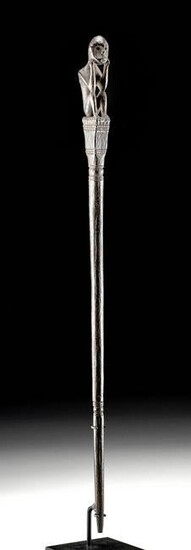20th C. Borneo Iban Dayak Wood Tun Tun / Charm Stick
Southeast Asia, Malaysia, western Borneo, Sarawak State, Iban Dayak people, ca. early 20th century CE. A hand-carved hardwood charm stick known as a tun tun used as a trap stick to capture wild animals. This tun tun is covered in dark brown pigment and has a slender body surmounted by a stylized ancestral figure. The figure is seated atop the rectangular plinth with elbows placed atop bent knees and hands held beneath the sloped cheeks. Tun tuns were used to measure the necessary height of the impaling spike, and the ancestor atop the pole is intended to symbolically lure the prey to the trap. These charms could also be placed at the four corners of an agricultural field to spiritually protect crops and encourage plant growth. Size: 0.9" W x 19.2" H (2.3 cm x 48.8 cm); 20.125" H (51.1 cm) on included custom stand.
Provenance: private Johnson collection, Los Angeles, California, USA
All items legal to buy/sell under U.S. Statute covering cultural patrimony Code 2600, CHAPTER 14, and are guaranteed to be as described or your money back.
A Certificate of Authenticity will accompany all winning bids.
We ship worldwide to most countries and handle all shipping in-house for your convenience.
#153052
Condition Report: Minor abrasions to figure and pole body, with a few stable hairline fissures, and very light encrustations, otherwise intact and very good. Great remains of brown pigment throughout.
View it on
Estimate
Time, Location
Auction House
Southeast Asia, Malaysia, western Borneo, Sarawak State, Iban Dayak people, ca. early 20th century CE. A hand-carved hardwood charm stick known as a tun tun used as a trap stick to capture wild animals. This tun tun is covered in dark brown pigment and has a slender body surmounted by a stylized ancestral figure. The figure is seated atop the rectangular plinth with elbows placed atop bent knees and hands held beneath the sloped cheeks. Tun tuns were used to measure the necessary height of the impaling spike, and the ancestor atop the pole is intended to symbolically lure the prey to the trap. These charms could also be placed at the four corners of an agricultural field to spiritually protect crops and encourage plant growth. Size: 0.9" W x 19.2" H (2.3 cm x 48.8 cm); 20.125" H (51.1 cm) on included custom stand.
Provenance: private Johnson collection, Los Angeles, California, USA
All items legal to buy/sell under U.S. Statute covering cultural patrimony Code 2600, CHAPTER 14, and are guaranteed to be as described or your money back.
A Certificate of Authenticity will accompany all winning bids.
We ship worldwide to most countries and handle all shipping in-house for your convenience.
#153052
Condition Report: Minor abrasions to figure and pole body, with a few stable hairline fissures, and very light encrustations, otherwise intact and very good. Great remains of brown pigment throughout.



